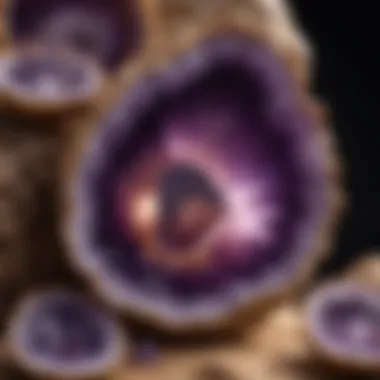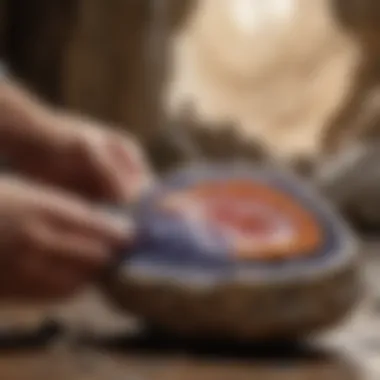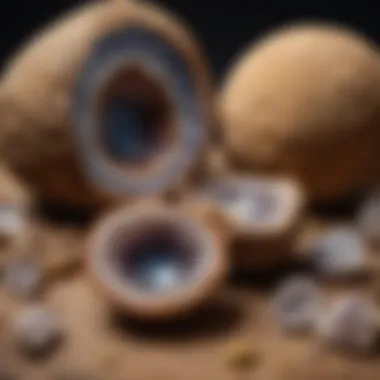Unraveling the Mysteries of Geodes: Expert Guide to Identifying Geodes


Rock and Fossil Identification
In the realm of geology, the identification of rocks extends far beyond mere aesthetic appreciation; it embodies a journey of scientific exploration and discovery. When it comes to geodes, recognizing their unique characteristics is essential for enthusiasts and collectors alike. Geodes, with their unassuming exterior and spectacular crystalline interior, captivate the imagination of rock aficionados worldwide. To decipher whether a rock harbors the wonder of a geode, one must first understand the defining features that set geodes apart from other geological formations.
One of the key characteristics that distinguish geodes is their spherical or oblong shape, often resembling an unassuming stone from the outside. However, it is what lies within that truly sets geodes apart – a hollow cavity lined with an array of sparkling crystals. These crystals form over millennia, creating intricate patterns and vibrant hues that mesmerize beholders. To identify a geode, one must look for clues such as the weight distribution, surface texture, and the presence of a discernible seam where the outer shell can be carefully cracked open to reveal the hidden crystal treasure within.
Unveiling the mystery of geodes requires a keen eye and an understanding of the geological processes that give rise to these natural wonders. By examining the size, shape, and coloration of a rock, collectors can begin to discern whether it conceals the secret beauty of a geode. While visual inspection is a vital aspect of identification, employing specialized tools such as rock hammers, chisels, and magnifying glasses can aid in the precise examination of a specimen. These tools enable collectors to explore the internal structure of a rock, unveiling its hidden secrets and unraveling the story of its formation.
Collecting Tips and Techniques
As avid rock enthusiasts venture into the realm of geode collection, understanding the best practices for acquiring these geological treasures is paramount. Whether scouring rocky outcrops, riverbeds, or quarries, knowing where to search and how to extract specimens safely is crucial for a successful collecting expedition. Geodes are often found in clusters or dispersed among other rocks, requiring patience and perseverance to uncover these hidden gems.
To optimize the collecting experience, researchers suggest exploring regions known for their geological diversity, such as areas rich in sedimentary or volcanic formations. These environments provide fertile ground for discovering a wide array of rocks, including the elusive geode. When extracting geodes from their natural habitat, it is essential to exercise caution to avoid damaging both the specimens and the surrounding geology. With gentle precision and the right tools, collectors can safely retrieve geodes without compromising their integrity.
In the pursuit of geodes, every step of the collection process is infused with excitement and anticipation as enthusiasts delve into the earth's treasure troves. By embracing best practices, rock sleuths can navigate the rugged terrain and unearth geological wonders that reveal the Earth's ancient past in all its crystalline splendor.
Preservation and Display
Once the quest for geodes culminates in a successful collection, the next imperative is preserving these natural marvels to retain their beauty and integrity for years to come. Preservation techniques play a vital role in safeguarding geodes from environmental factors that can degrade their exquisite crystals and mineral composition. Proper storage methods and climate control are essential for maintaining the stability of geodes, ensuring they remain pristine for future generations to admire.
Rock enthusiasts eager to showcase their prized geode collection can explore creative display ideas to accentuate the unique allure of these geological treasures. From illuminated stands that highlight the inner radiance of geodes to curated arrangements that showcase their diversity, there are myriad ways to exhibit these natural marvels in all their glory. By blending artistry with science, collectors can create captivating displays that elevate the beauty of geodes and inspire admiration for the wonders of the Earth.
Geological Insights
Delving deeper into the geological realm unveils a tapestry of formations and processes that shape the landscapes we inhabit. Geodes, with their enigmatic origins and crystalline interiors, offer a glimpse into the intricate mechanisms that govern the Earth's evolution over millions of years. Understanding the geological significance of rocks and fossils not only enriches our appreciation for the natural world but also fuels scientific inquiry and exploration.


The historical significance of rocks and fossils transcends their physical attributes, serving as invaluable markers of the Earth's past epochs. From fossilized remains that provide insights into prehistoric life forms to mineral formations that bear testament to ancient geological events, each rock tells a compelling tale of our planet's rich history. Notable discoveries in the field of geology continue to shape our understanding of the Earth's geological heritage, pushing the boundaries of knowledge and inspiring future generations of rock enthusiasts to unravel the mysteries concealed within the rocky layers of time.
Introduction
In the world of geology, geodes hold a mystical allure, captivating rock enthusiasts with their hidden wonders. This article serves as a guide to deciphering these enigmatic rocks, shedding light on the process of identifying geodes amidst a sea of stones. Understanding the unique characteristics of geodes is not only a fascinating venture but also a valuable skill for collectors and aspiring geologists alike. By unraveling the secrets of geodes, individuals can appreciate the geological processes that give rise to these exquisite formations.
What is a Geode?
A geode is a geological formation that presents a captivating facade, concealing a world of sparkling crystals within its unassuming exterior. These spherical or oblong rocks are hollow inside, often lined with mineral deposits that glitter when exposed to light. Geodes are like nature's treasure chests, offering a glimpse into the mesmerizing beauty created through millennia of geological activity. Their distinct structure sets them apart from other rocks, making them prized possessions for collectors and geology enthusiasts.
Significance of Geodes in the Geological World
Geodes play a crucial role in the geological world, offering valuable insights into the processes that shape the Earth's crust. Studying geodes provides scientists with information about mineral deposition, crystallization, and geological formations over time. Additionally, geodes serve as indicators of past environmental conditions, helping researchers piece together the puzzle of Earth's history. Their unique composition and formation contribute to the understanding of geological phenomena, making them essential subjects of study and admiration.
Purpose of the Guide
The purpose of this guide is to demystify the world of geodes and empower enthusiasts to identify these geological treasures with confidence. By equipping readers with knowledge about geode formation, distinguishing features, and practical identification techniques, this guide aims to foster a deeper appreciation for these natural marvels. Whether you are a seasoned collector or a novice rock enthusiast, this comprehensive resource will enhance your understanding of geodes and enrich your exploration of the fascinating realm of geological formations.
Understanding Geode Formation
In the realm of geology, understanding how geodes form plays a pivotal role in deciphering these enigmatic rocks. The process of geode formation is a mesmerizing journey of mineral deposition within cavities in sedimentary or volcanic rocks. This intricate process involves the gradual accumulation of various minerals, often triggered by water carrying dissolved minerals seeping into rock cavities over extended periods.
Knowing the nuances of geode formation is imperative for enthusiasts seeking to differentiate geodes from common rocks. By grasping the geological mechanisms underlying geode formation, rock enthusiasts can appreciate the unique patterns and structures that distinguish geodes from their ordinary counterparts. Furthermore, understanding geode formation enhances the ability to identify the geological forces at play and comprehend the historical context embedded within each geode.
Geological Process Behind Geode Formation


Delving deeper into the geological process behind geode formation unveils a fascinating tapestry of mineral crystallization and cavity filling. The initial stage usually involves the presence of a hollow space, whether created by volcanic bubbles or by other means, serving as the canvas for geode formation. Subsequently, mineral-rich solutions infiltrate these cavities, depositing layers of various minerals such as quartz, calcite, or amethyst.
As time progresses, these minerals crystallize within the cavity, forming the characteristic lining or layers that adorn the inner walls of the geode. Factors like temperature variations, pressure changes, and mineral composition all influence the crystallization process, contributing to the unique visual appeal of individual geodes. Understanding the geological intricacies behind geode formation unveils a world of artistic mineral arrangements and geological time capsules waiting to be deciphered.
Factors Influencing Geode Characteristics
The distinctive characteristics of geodes are not solely dictated by chance; rather, an interplay of factors shapes their aesthetic and structural profile. Various elements, including the type of dissolved minerals present, the conditions of mineral deposition, and the duration of the formation process, significantly influence geode characteristics.
Moreover, external factors like environmental conditions and the surrounding rock matrix also leave their imprint on geodes, imbuing them with unique colors, textures, and patterns. By unraveling the factors that influence geode characteristics, rock enthusiasts can appreciate the intricate interplay of geological processes that culminate in the creation of these geological marvels. Through a meticulous examination of these influencing factors, one can gain a deeper insight into the rich tapestry of geode diversity and unravel the geological mysteries concealed within these captivating rocks.
Physical Characteristics of Geodes
This section delves into the critical aspect of the physical characteristics of geodes, a cornerstone in the realm of geology. Understanding the physical attributes of geodes is paramount in accurately identifying these geological wonders. By examining the external appearance, internal structures, and distinctive features, enthusiasts can unravel the secrets hidden within these rocks. The examination of physical characteristics provides crucial insight into the formation and composition of geodes, offering a fascinating glimpse into the Earth's geological processes.
External Appearance
The external appearance of a geode is the initial point of contact for rock enthusiasts, providing valuable clues about its contents. Geodes typically exhibit a rough, nondescript exterior, often covered in a layer of sediment or mineral deposits. It is essential to observe the shape, size, and texture of the outer surface to determine the potential beauty held within. The color variations, patterns, and overall condition of the outer shell can indicate the type of minerals and crystals concealed inside the geode, guiding collectors in their quest for unique specimens.
Internal Structures
Exploring the internal structures of a geode unveils a mesmerizing world of crystals, minerals, and intricate formations. Geodes feature hollow cavities lined with an array of crystalline structures, ranging from sparkling quartz to vibrant amethyst. The internal layers, formations, and crystal patterns within a geode offer a glimpse into the geological history and environmental conditions that shaped these phenomena. By studying the internal structures, enthusiasts can appreciate the intricate beauty and scientific significance of geodes, fostering a deeper appreciation for these natural marvels.
Distinctive Features to Look For
When identifying geodes, specific distinctive features serve as key indicators of their authenticity and value. Look for unique crystal formations, such as druzy quartz or calcite crystals, nestled within the cavity of the geode. The presence of vibrant colors, intricate patterns, and well-defined crystal structures enhances the aesthetic appeal and collectible value of a geode. Additionally, examining the weight, density, and overall balance of the geode can provide further clues about its composition and the quality of crystals it may contain. By honing in on these distinctive features, collectors can distinguish prized geodes from common rocks, elevating their collection with unique and valuable specimens.


Identifying Geodes: Practical Techniques
In this section, we delve into the crucial aspect of identifying geodes through practical techniques, a cornerstone in our comprehensive guide on deciphering these intriguing rock formations. Understanding how to discern whether a rock is a geode is paramount for rock enthusiasts and collectors, as it allows for the appreciation and recognition of these geological wonders in their natural form. By focusing on practical techniques, we equip readers with the necessary skills to navigate the intricate world of geodes effectively.
Visual Inspection
Visual inspection is a fundamental technique in identifying geodes, providing valuable insights into the external characteristics of the rock. By closely examining the external appearance of a rock, enthusiasts can look for telltale signs that differentiate geodes from other rocks. Factors such as shape, texture, and color can offer clues as to whether a rock is a geode or not. Additionally, scrutinizing any potential crystalline structures or unusual patterns on the surface can further aid in the identification process. Visual inspection sets the foundation for further analysis and plays a pivotal role in the geode identification journey.
Weight and Density Analysis
Conducting weight and density analysis is a critical step in the identification of geodes, offering valuable insights into the internal composition of the rock. By comparing the weight and density of a suspected geode to known geological data, enthusiasts can make informed assessments regarding the likelihood of the rock being a geode. Differences in weight distribution or density patterns can indicate the presence of hollow cavities or crystalline formations typical of geodes. This analytical approach provides a quantitative basis for geode identification and enhances the overall accuracy of the process.
Sound Test
Employing a sound test is a practical technique used to distinguish geodes from other rocks based on auditory feedback. By tapping gently on the surface of a rock, enthusiasts can listen for distinct acoustic properties that are indicative of a hollow interior, characteristic of geodes. The resonance produced by the rock can offer valuable insights into its internal structure, helping differentiate geodes from solid rocks or mineral deposits. The sound test serves as a sensory tool in the geode identification process, adding another dimension to the overall analysis.
Cracking Open a Geode
Cracking open a geode is a hands-on technique that allows enthusiasts to explore the hidden treasures within these geological marvels. By utilizing appropriate safety measures and tools, such as a geode cracker, rock enthusiasts can reveal the internal structures and crystalline formations unique to geodes. The process of cracking open a geode not only provides a glimpse into its intricate beauty but also offers a hands-on experience that deepens one's connection to these natural wonders. This technique adds an element of excitement and discovery to the geode identification process, making it an essential step for any rock enthusiast.
Distinguishing Geodes from Similar Rocks
Distinguishing geodes from similar rocks is a critical aspect of this article as it aids rock enthusiasts in accurately identifying these geological marvels. By highlighting the unique characteristics and formation processes of geodes compared to other rocks, readers can develop a keen eye for differentiating them. Understanding these distinctions is vital for rock collectors as it ensures that they add authentic geodes to their collection rather than misidentifying common rocks. By delving into the variances between geodes and nodules, readers can grasp the specific features that set these rocks apart. This section serves as a crucial guide for individuals seeking to enhance their knowledge of geology and expand their collection with genuine geodes.
Difference Between Geodes and Nodules
Differentiating between geodes and nodules is a key aspect of rock identification, as these two geological formations share similarities but also possess distinctive differences. Geodes are geological structures with crystal-lined interiors that form inside cavities within rocks, typically originating from sedimentary or volcanic processes. On the other hand, nodules are rounded mineral concretions found within rock strata, often lacking the crystalline formations evident in geodes. The key disparity lies in the internal composition, with geodes exhibiting intricate crystal patterns while nodules typically showcase solid mineral structures without the same level of complexity. By understanding these nuances, rock enthusiasts can accurately identify whether a rock is a geode or a nodule based on its internal characteristics, aiding in building a comprehensive rock collection.
Contrasting Geodes with Lava Rocks
Drawing a distinction between geodes and lava rocks is essential for rock collectors to avoid misidentifying these rocks due to their similar appearances. Geodes are formed through mineral-rich water seeping into cavities in rocks, crystallizing over time and creating stunning internal structures. In comparison, lava rocks, also known as volcanic rocks, are igneous rocks formed from molten lava cooling and solidifying. While both geodes and lava rocks may exhibit porous textures on their outer surfaces, geodes possess distinct crystal formations within their cavities, a feature absent in lava rocks. By contrasting the formation processes and internal structures of geodes with lava rocks, rock enthusiasts can refine their identification skills and accurately categorize these rocks within their collections, ensuring a deeper appreciation for the unique beauty of geodes.







